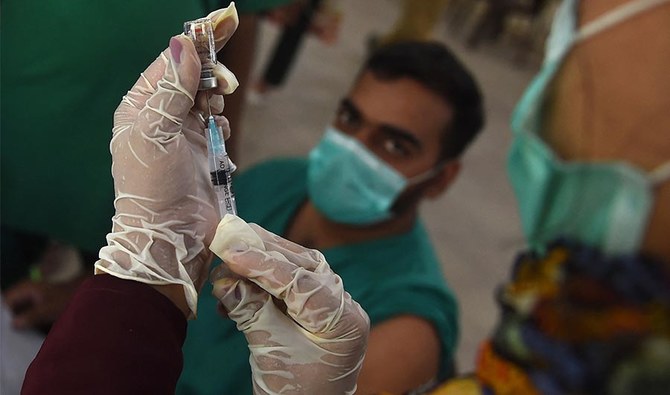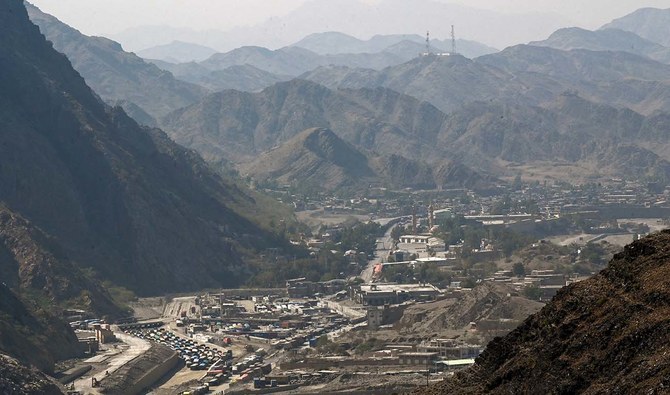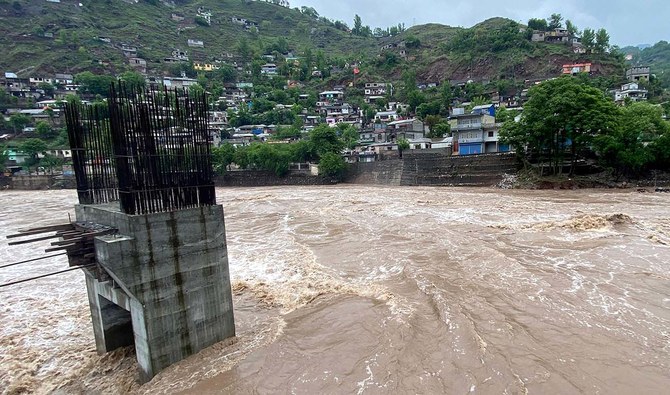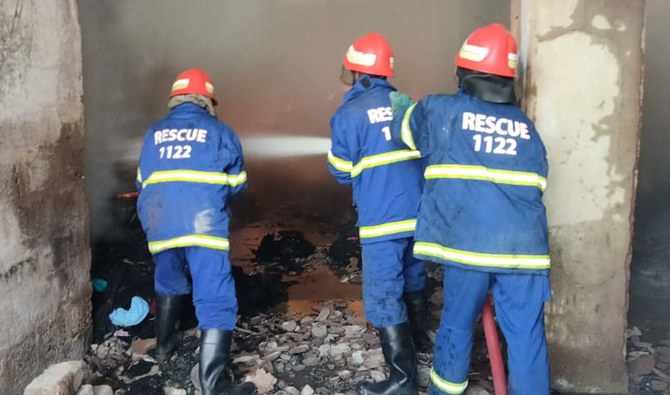ISLAMABAD/LAHORE: The Pakistani capital is leading in the country in administering COVID-19 vaccines to its eligible population, with health ministry data up until September 30 showing that over 85 percent percent of people in Islamabad had received a first dose and 47 percent were fully vaccinated, while only 15 percent of the target group in the country’s least populous province of Balochistan had as yet been administered one jab.
The government of Prime Minister Imran Khan launched a national vaccination drive in February this year, prioritizing health care workers and elderly citizens before broadening the campaign to the public. Now in the fourth wave of the pandemic, Pakistani officials say a ramped up vaccination campaign has helped to push daily infection rates down from a peak of over nine percent in August to less than two percent currently.
Around 125 million of Pakistan’s 220 million total population is eligible to receive a coronavirus vaccine. Among the eligible population, around 90 million have received at least one dose since February, health ministry data shows.
As of Monday this week, fully vaccinated Pakistanis constituted 26 percent of the target population, with all federating units saying they were ramping up efforts to boost daily vaccination rates by launching door-to-door campaigns and forbidding unjabbed people from using public transportation, air travel, buying fuel at petrol stations and availing other essential services.
“COVID-19 vaccination has helped us reduce severity of disease and hospitalization rates among those infected with the virus in Islamabad,” Dr. Hasan Orooj, Director General Health Services in Islamabad, told Arab News, saying the administration was vaccinating eligible people at public transport stands, weekly bazaars and public and private offices also.
“We [Islamabad] are well ahead of our [vaccination] target, but still people should continue to follow health guidelines to prevent the next wave,” Orooj cautioned, adding that his teams were also working to bridge a existing vaccination gap between rural and urban areas of the capital.
“The vaccination numbers in Islamabad’s rural areas are comparatively low, and we are mobilizing our special teams to bring it at par with urban areas,” he said.
According to official data collected by Arab News from all four provinces and Islamabad, the impoverished Balochistan province has the lowest vaccination rates, with only seven percent of the province fully vaccinated and 15 percent partially jabbed. The province is Pakistan’s largest — it makes up over 40 percent of the total land area of Pakistan — but least populous.
Statistics show a total of 1.25 million individuals — including people from other cities — had received at least one dose of a vaccine in Islamabad as of last week, though only 686,905 people had been fully vaccinated.
Islamabad’s eligible population for the COVID-19 vaccination is about 1.46 million, of which 47 percent is fully vaccinated, health department data showed.
PUNJAB
In Punjab, 45 percent people are partially vaccinated, followed by 39 percent in Khyber Pakhtunkhwa province, 35.53 percent in Sindh and 15 percent in Balochistan.
Punjab Health Secretary Imran Sikandar Baloch said approximately 233 million people in the province had been administered a first dose, while a second dose had been administered to more than 10 million people.
“Punjab is leading the national vaccination drive both in numbers and percentages,” Baloch said.
Sharing the vaccination data of major cities in the province, the secretary said 58 percent of Rawalpindi’s population had been administered the first dose, 53 percent of Multan’s, 51 percent of Lahore’s, 52 percent of Gujranwala’s and 41 percent of Faisalabad’s.
The districts of Jhelum and Mandi Bahauddin had partially vaccinated 69 percent and 62 percent eligible individuals respectively, the secretary said.
To boost inoculation numbers, Baloch said the provincial government had devised door-to-door campaigns especially in rural and hard-to-reach areas.
“We have also decided to target small populated units with mobile vaccination centers,” he added.
SINDH
In Sindh province, 35.53 percent of 34.8 million eligible individuals had been partially vaccinated, according to the health department. The number of those who had received at least one dose in the province stood at 12.4 million while 5.4 million were fully vaccinated, according to official data compiled until Thursday.
Data from the different divisions of Sindh showed Karachi division was 42.81 percent partially vaccinated, Hyderabad division 29.68 percent, Sukkur division 26.03 percent, Mirpur Khas division 48.94 percent, Shaheed Benazir Abad division 34.06 percent and Larkana division 24.54 percent.
Sindh had administered 150,000 vaccines per day on average in the last two weeks in Sindh province, Mehar Khursheed, a spokesperson for the Sindh Health Department, said.
Sindh is home to Pakistan’s port city of Karachi, the nation’s financial hub, where the vaccine rate is higher than in other parts of the province.
Khursheed said the vaccination rate was high in urban districts due to high awareness among people, while the district administration was strictly implementing an obligatory vaccine regime to improve vaccination numbers in low-performing districts.
“Sindh is the first province that has taken bold steps in terms of the obligatory regime to increase in vaccination coverage like blocking mobile phone SIMs, banning commercial activities and travel by unvaccinated people,” Khursheed told Arab News.
KHYBER PAKHTUNKHWA
In Khyber Pakhtunkhwa province, authorities have partially vaccinated around 39 percent of its target population. Overall, more than nine million people from the northwestern province had received a first dose while 3.2 million were fully vaccinated, according to the provincial health department.
Dr. Niaz Muhammad, Director General KP health, said some districts such as Abbottabad, Haripur, Mansehra, Chitral, Orakzai, Peshawar and Kurram had good vaccination results but poor awareness continued to fuel vaccine hesitancy and low immunization rates in other areas.
“We are sending outreach teams in view of reluctance among some people and carrying out mass door-to-door vaccination,” Muhammad told Arab News. “People had some concerns due to some media reports coupled with poor awareness but we’re working to improve our communication strategy.”
In addition, he said the government had already announced an obligatory vaccine regime under which the transport sector and school children would need to have received one COVID-19 dose by October 15.
BALOCHISTAN
In Balochistan, official data showed that around 1,482,791 people had been vaccinated in 33 districts of the province between February and September.
Dr. Naqeeb Niazi, Deputy In-charge Operation Cell Primary and Secondary Health Department in Balochistan, said first dose coverage in the province had reached up to 15 percent while only seven percent were fully vaccinated — the lowest vaccination rate in the country.
“We have been implementing an obligatory regime of vaccination from October 1, and hope the vaccination number will increase in districts with low numbers by October 31,” Niazi told Arab News.
A senior official at the National Command and Operation Center (NCOC), Pakistan’s federal pandemic response body, said vaccination rates varied “because of the peculiar environment and population of every province.”
“Punjab is leading the vaccination drive among provinces because it is the most populated territory in the country,” he said, declining to be named. “Similarly the low turnout in Balochistan is due to its geographic location, not because of less government motivation to vaccinate the provincial population.”
He said people in the remote, sparsely populated Balochistan province had to travel long distances to reach vaccination centers, while lack of awareness and misinformation also continued to fuel low rates in the region.
“Vaccination numbers are usually low in rural areas of the country for different reasons, including low motivation and luxury to avoid government-imposed restrictions because they don’t need to travel by air or go to restaurants for which it is mandatory to get vaccinated now,” the official said.
- Additional reporting by Naimat Khan in Karachi, Rehmat Mehsud in Peshawar and Saadullah Akhter in Quetta
85% of capital city partially jabbed against COVID-19, only 15% of Pakistan’s largest province — data
https://arab.news/wrxww
85% of capital city partially jabbed against COVID-19, only 15% of Pakistan’s largest province — data

- Arab News gathers vaccine data from Islamabad and four provinces, all figures are with respect to eligible population until September 30
- Fully vaccinated Pakistanis constituted 26 percent of target population of 125 million, 47 percent people in Islamabad fully jabbed
Pakistan committee discusses development of border areas in inaugural session

- The committee was formed to devise comprehensive strategies for holistic development in Pakistan’s border regions
- Key topics that came under discussion at the inaugural session included tariff rationalization, employment creation
ISLAMABAD: A high-level committee tasked with development of Pakistan’s border regions on Saturday held its inaugural session in Islamabad to discuss the challenges facing communities based in the country’s frontier regions, the Pakistani commerce ministry said.
The inaugural session of the committee, which was formed to devise comprehensive strategies for holistic development in these areas, was presided over by Commerce Minister Jam Kamal Khan, according to the ministry.
Key topics that came under discussion at the meeting included tariff rationalization and employment creation, reflecting the committee’s commitment to addressing border communities’ challenges.
“The committee aims to present its recommendations to the Prime Minister within 10 days, signaling a promising start to collaborative efforts for socio-economic development in the region,” the commerce ministry said in a statement.
Pakistan shares a long, porous border with Iran and Afghanistan, with people live along it relying on cross-border trade with little or no government tariffs, quotas, subsidies or prohibitions.
Islamabad last year announced restrictions on the informal trade to discourage smuggling of goods and currency in order to support the country’s dwindling economy.
Pakistan’s trade with China mostly takes place through formal channels, while the country’s trade ties with India, another neighbor it shares border with, remain suspended since 2019 over the disputed region of Kashmir.
Pakistan records ‘wettest April’ in more than 60 years — weather agency

- Pakistan’s metrology department says April rainfall was recorded at 59.3 millimeters, ‘excessively above’ the normal average of 22.5 millimeters
- There were at least 144 deaths in thunderstorms and house collapses due to heavy rains in what the report said was the ‘wettest April since 1961’
ISLAMABAD: Pakistan experienced its “wettest April since 1961,” receiving more than twice as much rain as usual for the month, the country’s weather agency said in a report.
April rainfall was recorded at 59.3 millimeters, “excessively above” the normal average of 22.5 millimeters, Pakistan’s metrology department said late Friday in its monthly climate report.
There were at least 144 deaths in thunderstorms and house collapses due to heavy rains in what the report said was the “wettest April since 1961.”
Pakistan is increasingly vulnerable to unpredictable weather, as well as often destructive monsoon rains that usually arrive in July.
In the summer of 2022, a third of Pakistan was submerged by unprecedented monsoon rains that displaced millions of people and cost the country $30 billion in damage and economic losses, according to a World Bank estimate.
“Climate change is a major factor that is influencing the erratic weather patterns in our region,” Zaheer Ahmad Babar, spokesperson for the Pakistan Meteorological Department, said while commenting on the report.
While much of Asia is sweltering dure to heat waves, Pakistan’s national monthly temperature for April was 23.67 degrees Celsius (74 degrees Fahrenheit) 0.87 degrees lower than the average of 24.54, the report noted.
Fire erupts at Karachi garment factory, no loss of live reported

- The biggest Pakistani city, known for poor fire safety protocols, witnesses hundreds of such incidents annually
- In November last year, a blaze at a shopping mall in Karachi killed around a dozen people and injured several others
KARACHI: A fire broke out at a garment factory in the southern Pakistani city of Karachi on Saturday, rescue officials said.
The blaze erupted on the ground floor of the garment factory in Zarina Colony in the New Karachi area, according to Rescue 1122 service.
“One fire truck is actively participating in the operation,” a Rescue 1122 spokesperson said, adding that another fire tender has been called to the site.
No loss of life has been reported in the wake of the fire.
Karachi, Pakistan’s largest city and the main commercial hub, is home to hundreds of thousands of industrial units and some of the tallest buildings in the South Asian country.
The megapolis, known for its fragile firefighting system and poor safety controls, witnesses hundreds of such incidents annually.
In Nov., a blaze at a shopping mall killed around a dozen people and injured several others. In April last year, four firefighters died and nearly a dozen others were injured after a fire broke out at a garment factory, while 10 people were killed in a massive fire at a chemical factory in the city in August 2021.
In the deadliest such incident, 260 people were killed in 2012 after being trapped inside a garment factory when a fire broke out.
Saleem Haider Khan, Faisal Kundi named governors of Pakistan’s Punjab, Khyber Pakhtunkhwa provinces

- Nominations come as part of power-sharing deal between PM Sharif’s party and ex-FM Bhutto-Zardari-led faction
- According to the deal, the PPP backed Sharif for the prime minister’s office in return for constitutional positions
ISLAMABAD: The Pakistan Peoples Party (PPP), a coalition partner in Prime Minister Shehbaz Sharif’s government, has nominated Saleem Haider Khan and Faisal Karim Kundi as governors of Pakistan’s eastern Punjab and northwestern Khyber Pakhtunkhwa provinces, the PPP chairman announced on Friday.
The PPP forged an alliance with PM Sharif’s Pakistan Muslim League-Nawaz (PML-N) party after Pakistan’s national election on February 8 failed to present a clear winner.
According to the power-sharing deal, the PPP backed Sharif for the prime minister’s office in return for the presidency, chairman of Senate and other important constitutional positions.
In a post on X, PPP Chairman Bilawal Bhutto-Zardari congratulated Khan and Kundi, and extended his good wishes to them
“I am confident they [Khan and Kundi] will perform their duties with the dignity their new office demands,” he said on X.
In Pakistan, a governor is a representative of the state to a province, who is appointed by the president on the advice of the prime minister.
Such positions may seem ceremonial and symbolic, but they do hold significant constitutional importance.
At present, PML-N’s Balighur Rehman has been serving as the Punjab governor, while JUI-F’s Hajji Ghulam Ali holds the post in KP.
Bhutto-Zardari also called on PM Sharif in Islamabad, following the nominations, Pakistani state media reported.
“During the meeting, views were exchanged on overall political situation in the country and matters of national interest,” the Radio Pakistan broadcaster said.
Pakistan Cricket Board confirms details of national side’s South Africa tour

- The side will depart for Durban on December 2 after returning from Australia in Nov.
- The ODIs will be played from December 17-22 in Paarl, Cape Town, and Johannesburg
ISLAMABAD: The Pakistan Cricket Board (PCB) on Friday announced details of the Pakistan men’s cricket team’s tour of South Africa for three Twenty20, three one-day international and two Test matches in the second half of 2024.
Durban, Centurion, and Johannesburg will host the T20Is from December 10-14, according to the PCB. The ODIs will be played from December 17-22 in Paarl, Cape Town, and Johannesburg, while the two ICC World Test Championship 2023-25 matches will be held at Centurion (December 26-30) and Cape Town (January 3-7).
The side will depart for Durban on December 2 after returning from Australia on November 19, having featured in a series of three ODIs and three T20Is from November 4-18. After completing their African safari on January 8, Pakistan will take on New Zealand and South Africa in a three-nation ODI tournament on home turf, which will be followed by the eight-team ICC Champions Trophy 2025 in Pakistan.
“Prior to the tours of Australia and South Africa, Pakistan will host Bangladesh and England for two and three Tests, respectively,” the PCB said in a statement. “This means they will play seven Tests, minimum of 10 ODIs, and six T20Is in the six-month period from August 2024 to January 2025.”
This will be Pakistan’s seventh Test tour of South Africa since 1994-95. Their two Test wins were in the 1997-98 and 2006-2007 series.
In the Durban Test in 1997-98, Pakistan won by 29 runs at the back of centuries from Azhar Mahmood (132) and Saeed Anwar (118), match figures of nine for 149 by Mushtaq Ahmed and a first innings five-fer by Shoaib Akhtar. In the 2006-2007 Port Elizabeth Test, Pakistan won by five wickets with Inzamam-ul-Haq being named as Player of the Match for his 92 in the first innings.
In ODIs, Pakistan has won two of the last three series in 2013-2014 and 2020-21, while South Africa triumphed in 2002-2003 (4-1), 2006-2007 (3-1), 2012-2013 (3-2), and 2018-2019 (3-2).
In 12 T20Is to date, Pakistan leads 6-5 in head-to-head encounters, with one match ending in no-result.
Tour schedule:
10 Dec – 1st T20I, Durban
13 Dec – 2nd T20I, Centurion
14 Dec – 3rd T20I, Johannesburg
17 Dec – 1st ODI, Paarl
19 Dec – 2nd ODI, Cape Town
22 Dec – 3rd ODI, Johannesburg
26-30 Dec – 1st Test, Centurion
3-7 Jan – 2nd Test, Cape Town










